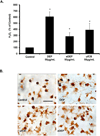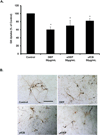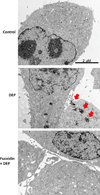The role of MAC1 in diesel exhaust particle-induced microglial activation and loss of dopaminergic neuron function
- PMID: 23470120
- PMCID: PMC3660420
- DOI: 10.1111/jnc.12231
The role of MAC1 in diesel exhaust particle-induced microglial activation and loss of dopaminergic neuron function
Abstract
Increasing reports support that air pollution causes neuroinflammation and is linked to central nervous system (CNS) disease/damage. Diesel exhaust particles (DEP) are a major component of urban air pollution, which has been linked to microglial activation and Parkinson's disease-like pathology. To begin to address how DEP may exert CNS effects, microglia and neuron-glia cultures were treated with either nanometer-sized DEP (< 0.22 μM; 50 μg/mL), ultrafine carbon black (ufCB, 50 μg/mL), or DEP extracts (eDEP; from 50 μg/mL DEP), and the effect of microglial activation and dopaminergic (DA) neuron function was assessed. All three treatments showed enhanced ameboid microglia morphology, increased H2 O2 production, and decreased DA uptake. Mechanistic inquiry revealed that the scavenger receptor inhibitor fucoidan blocked DEP internalization in microglia, but failed to alter DEP-induced H2 O2 production in microglia. However, pre-treatment with the MAC1/CD11b inhibitor antibody blocked microglial H2 O2 production in response to DEP. MAC1(-/-) mesencephalic neuron-glia cultures were protected from DEP-induced loss of DA neuron function, as measured by DA uptake. These findings support that DEP may activate microglia through multiple mechanisms, where scavenger receptors regulate internalization of DEP and the MAC1 receptor is mandatory for both DEP-induced microglial H2 O2 production and loss of DA neuron function.
© 2013 International Society for Neurochemistry.
Conflict of interest statement
The authors report no conflicts of interest.
Figures






References
-
- Akiyama H, McGeer PL. Brain microglia constitutively express beta-2 integrins. J Neuroimmunol. 1990;30:81–93. - PubMed
-
- Block ML, Wu X, Pei Z, et al. Nanometer size diesel exhaust particles are selectively toxic to dopaminergic neurons: the role of microglia, phagocytosis, and NADPH oxidase. FASEB J. 2004;18:1618–1620. - PubMed
-
- Block ML, Zecca L, Hong JS. Microglia-mediated neurotoxicity: uncovering the molecular mechanisms. Nat Rev Neurosci. 2007;8:57–69. - PubMed
-
- Bolton JL, Smith SH, Huff NC, Gilmour MI, Foster WM, Auten RL, Bilbo SD. Prenatal air pollution exposure induces neuroinflammation and predisposes offspring to weight gain in adulthood in a sex-specific manner. FASEB J. 2012;26:4743–4754. - PubMed
Publication types
MeSH terms
Substances
Grants and funding
LinkOut - more resources
Full Text Sources
Other Literature Sources
Molecular Biology Databases
Research Materials

